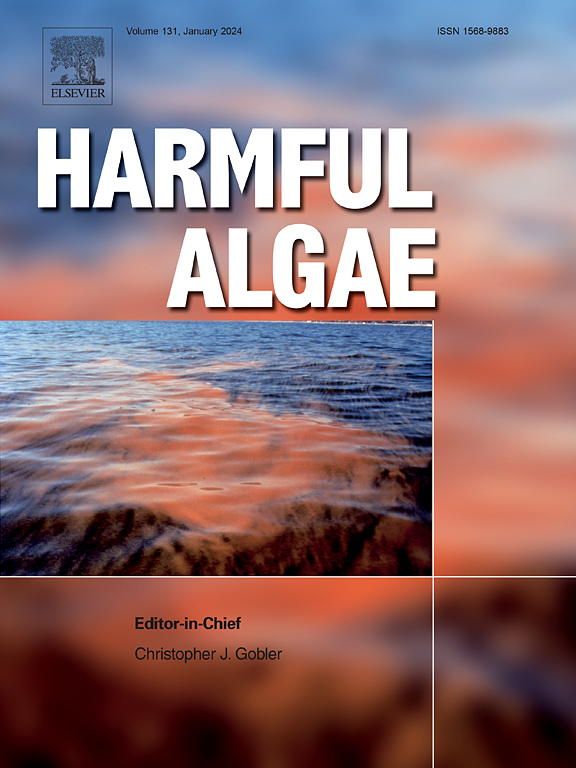Rapid and sensitive detection of Karlodinium veneficum using RAA and CRISPR-Cas12a technologies
IF 4.5
1区 生物学
Q1 MARINE & FRESHWATER BIOLOGY
引用次数: 0
Abstract
The harmful algal species Karlodinium veneficum (K. veneficum) poses a significant threat to aquatic ecosystems, economic stability, and human health due to its toxin production and widespread occurrence. Rapid climatic changes and eutrophication have intensified harmful algal blooms (HABs), making the timely detection of K. veneficum critical. To address this need, we developed a rapid and accurate detection method of K. veneficum by combining Recombinase Aided Amplification (RAA) with CRISPR/LbCas12a. This method targets the internal transcribed spacer (ITS) sequence of K. veneficum and utilizes the "collateral activity" of CRISPR/LbCas12a for visualization. Our method can detect plasmid DNA as low as 5.9 × 102 copies/µL and genomic DNA as low as 3.6 × 10−2 ng/µL, achieving a detection limit of 10 cells of K. veneficum through a simplified DNA extraction process. The entire detection process, from DNA crude extract to result visualization, can be completed in as fast as 90 min, making it suitable for field applications requiring a rapid response. In addition, our method was validated against a wide range of non-target microalgae species, confirming its specificity to K. veneficum and eliminating the risk of cross-reactivity. Overall, the RAA-CRISPR/LbCas12a system is simple, accurate, and sensitive, showing great potential for field applications in monitoring K. veneficum.
利用RAA和CRISPR-Cas12a技术快速、灵敏地检测veneficum
有害藻类veneficum Karlodinium veneficum (K. veneficum)由于其毒素的产生和广泛的分布,对水生生态系统、经济稳定和人类健康构成了重大威胁。快速的气候变化和富营养化加剧了有害藻华(HABs),使得及时发现veneficum至关重要。为了解决这一需求,我们将重组酶辅助扩增(Recombinase Aided Amplification, RAA)技术与CRISPR/LbCas12a技术相结合,开发了一种快速准确的veneficum检测方法。该方法以veneficum的内部转录间隔序列(ITS)为靶点,利用CRISPR/LbCas12a的“侧枝活性”进行可视化。我们的方法可以检测到低至5.9 × 102拷贝/µL的质粒DNA和低至3.6 × 10−2 ng/µL的基因组DNA,通过简化的DNA提取工艺,达到10个细胞的检出限。从DNA粗提取到结果可视化的整个检测过程可在90分钟内完成,适用于需要快速响应的现场应用。此外,我们的方法在广泛的非靶微藻物种中进行了验证,证实了其对veneficum的特异性,并消除了交叉反应的风险。综上所述,RAA-CRISPR/LbCas12a系统具有简单、准确、灵敏等特点,在现场监测veneficum方面具有很大的应用潜力。
本文章由计算机程序翻译,如有差异,请以英文原文为准。
求助全文
约1分钟内获得全文
求助全文
来源期刊

Harmful Algae
生物-海洋与淡水生物学
CiteScore
12.50
自引率
15.20%
发文量
122
审稿时长
7.5 months
期刊介绍:
This journal provides a forum to promote knowledge of harmful microalgae and macroalgae, including cyanobacteria, as well as monitoring, management and control of these organisms.
 求助内容:
求助内容: 应助结果提醒方式:
应助结果提醒方式:


